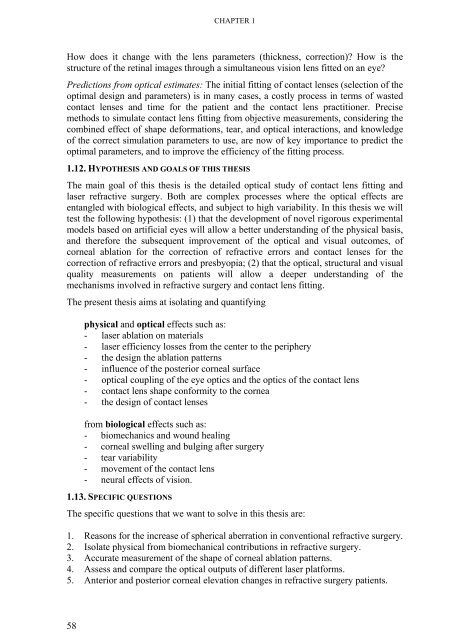Low_resolution_Thesis_CDD_221009_public - Visual Optics and ...
Low_resolution_Thesis_CDD_221009_public - Visual Optics and ...
Low_resolution_Thesis_CDD_221009_public - Visual Optics and ...
Create successful ePaper yourself
Turn your PDF publications into a flip-book with our unique Google optimized e-Paper software.
CHAPTER 1<br />
How does it change with the lens parameters (thickness, correction) How is the<br />
structure of the retinal images through a simultaneous vision lens fitted on an eye<br />
Predictions from optical estimates: The initial fitting of contact lenses (selection of the<br />
optimal design <strong>and</strong> parameters) is in many cases, a costly process in terms of wasted<br />
contact lenses <strong>and</strong> time for the patient <strong>and</strong> the contact lens practitioner. Precise<br />
methods to simulate contact lens fitting from objective measurements, considering the<br />
combined effect of shape deformations, tear, <strong>and</strong> optical interactions, <strong>and</strong> knowledge<br />
of the correct simulation parameters to use, are now of key importance to predict the<br />
optimal parameters, <strong>and</strong> to improve the efficiency of the fitting process.<br />
1.12. HYPOTHESIS AND GOALS OF THIS THESIS<br />
The main goal of this thesis is the detailed optical study of contact lens fitting <strong>and</strong><br />
laser refractive surgery. Both are complex processes where the optical effects are<br />
entangled with biological effects, <strong>and</strong> subject to high variability. In this thesis we will<br />
test the following hypothesis: (1) that the development of novel rigorous experimental<br />
models based on artificial eyes will allow a better underst<strong>and</strong>ing of the physical basis,<br />
<strong>and</strong> therefore the subsequent improvement of the optical <strong>and</strong> visual outcomes, of<br />
corneal ablation for the correction of refractive errors <strong>and</strong> contact lenses for the<br />
correction of refractive errors <strong>and</strong> presbyopia; (2) that the optical, structural <strong>and</strong> visual<br />
quality measurements on patients will allow a deeper underst<strong>and</strong>ing of the<br />
mechanisms involved in refractive surgery <strong>and</strong> contact lens fitting.<br />
The present thesis aims at isolating <strong>and</strong> quantifying<br />
physical <strong>and</strong> optical effects such as:<br />
- laser ablation on materials<br />
- laser efficiency losses from the center to the periphery<br />
- the design the ablation patterns<br />
- influence of the posterior corneal surface<br />
- optical coupling of the eye optics <strong>and</strong> the optics of the contact lens<br />
- contact lens shape conformity to the cornea<br />
- the design of contact lenses<br />
from biological effects such as:<br />
- biomechanics <strong>and</strong> wound healing<br />
- corneal swelling <strong>and</strong> bulging after surgery<br />
- tear variability<br />
- movement of the contact lens<br />
- neural effects of vision.<br />
1.13. SPECIFIC QUESTIONS<br />
The specific questions that we want to solve in this thesis are:<br />
1. Reasons for the increase of spherical aberration in conventional refractive surgery.<br />
2. Isolate physical from biomechanical contributions in refractive surgery.<br />
3. Accurate measurement of the shape of corneal ablation patterns.<br />
4. Assess <strong>and</strong> compare the optical outputs of different laser platforms.<br />
5. Anterior <strong>and</strong> posterior corneal elevation changes in refractive surgery patients.<br />
58











